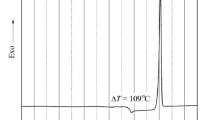Abstract
The temperature–concentration dependences of the electrical conductivity and the activation energy for electrical conduction of glasses in the Na2O–B2O3 and Na2O–2PbO · B2O3 systems are studied. The investigation into the nature of the electrical conduction in these glasses reveals that the contribution from the electronic component (10–3%) of the conductivity is within the sensitivity of the Liang–Wagner technique. A considerable alkali conductivity is observed upon introduction of more than ∼12 mol % Na2O. The true transport number of sodium η Na is as large as unity at [Na2O] ≅ 15 mol %. It is shown that the observed temperature–concentration dependences of the electrical and transport properties are governed by the ratio between the concentrations of polar and nonpolar structural–chemical units of the Na+[BO4/2]–, Na+[O–BO2/2] ⇒ Na+[O–BO2/2], Pb2+ 1/2[BO4/2]–, Pb2+ 1/2[O–BO2/2], and [BO3/2] types.
Similar content being viewed by others
REFERENCES
Mazurin, O.V., Streltsina, M.V., and Shvaiko-Shvaikovskaya, T.P., Svoistva stekol i stekloobrazuyushchikh rasplavov. Spravochnik, vol. 2: Odnokomponentnye i dvukhkomponentnye okisnye nesilikatnye sistemy, Leningrad: Nauka, 1975. Translated under the title Handbook of Glass Data: Part B. Single-Component and Binary Non-Silicate Oxide Glasses: Physical Science Data 15, Amsterdam: Elsevier, 1985.
Sokolov, I.A., Murin, I.V., Naraev, V.N., and Pronkin, A.A., On the Nature of Current Carriers in Alkali-Free Glass Based on Silicon, Boron, and Phosphorus Oxides, Fiz. Khim. Stekla, 1999, vol. 25, no. 5, pp. 593–613 [Glass Phys. Chem. (Engl. transl.), 1999, vol. 25, no. 5, pp. 454-468].
Mazurin, O.V., Electrical Properties of Glasses, Tr. Leningr. Tekhnol. Inst. im. Lensoveta, 1962, no. 62.
Sokolov, I.A., Naraev, V.N., Nosakin, A.N., and Pronkin, A.A., Influence of MeF2 (Me = Mg, Ca, Sr, and Ba) on the Electrical Properties of Glasses in the MeF2- Na2B4O7 System, Fiz. Khim. Stekla, 2000, vol. 26, no. 4, pp. 548–556 [Glass Phys. Chem. (Engl. transl.), 2000, vol. 26, no. 4, pp. 383-389].
Sokolov, I.A., Murin, I.V., Wiemhöfer H.-D., and Pronkin A.A. The Nature of Electric Conductivity in the PbO-SiO2 Glasses, Fiz. Khim. Stekla, 1998, vol. 24, no.2, pp. 158–167 [Glass Phys. Chem. (Engl. transl.), 1998, vol. 24, no. 2, pp. 112-118].
Sokolov, I.A., Naraev, V.N., Nosakin, A.N., and Pronkin, A.A., On the Nature of Current Carriers in Glasses of the NaF-Na2O-B2O3 System, Fiz. Khim. Stekla, 2000, vol. 26, no. 6, pp. 848–853 [Glass Phys. Chem. (Engl. transl.), 2000, vol. 26, no. 6, pp. 584-587].
Wagner, C., Galvanic Cells with Solid Electrolytes Involving Ionic and Electronic Conduction, Proceedings of the VII Meeting of the International Commission on Electrochemical, Thermal, and Kinetic Processes, London, 1955, London: Butterworth, 1957, pp. 361–389.
Liang, C.C., Determination of the Electronic Transference Numbers of Solid Electrolytes, Trans. Faraday Soc., 1969, vol. 65, no. 564, pp. 3369–3374.
Franz, H. and Scholze, H., Die Löslichkeit von H2O- Dampf in Glasschmelzen verschiedener Basizitat, Glastech. Ber., 1963, vol. 36, no. 9, pp. 347–356.
Kanchieva, O.N., Komarova, N.V., Nemilov, S.V., and Tagantsev, D.K., Effect of Water Content on the Viscosity of Vitreous Na2O · 2SiO2, PbO · 2B2O3, and CaO · P2O5, Fiz. Khim. Stekla, 1980, vol. 6, no. 4, pp. 408–414.
Mazurin, O.V., Streltsina, M.V., and Shvaiko-Shvaikovskaya, T.P., Svoistva stekol i stekloobrazuyushchikh rasplavov. Trekhkomponentnye nesilikatnye okisnye sistemy. Spravochnik, Leningrad: Nauka, 1979, vol. 3, part 2. Translated under the title Handbook of Glass Data: Part E. Single-Component, Binary, and Ternary Non-Silicate Oxide Glasses, Supplements to Parts A, B, C, and D: Physical Science Data 15, Amsterdam: Elsevier, 1993.
Myuller, R.L. and Shchukarev, S.A., A Study of the Electrical Conductivity of Glasses in the B2O3-Na2O System, Zh. Fiz. Khim., 1930, vol. 1, no. 6, pp. 625–661.
Myuller, R.L., Elektroprovodnost' stekloobraznykh veshchestv. Sbornik trudov (Electrical Conductivity of Vitreous Compounds: A Collection of Articles), Leningrad: Leningr. Gos. Univ., 1968.
Shong, J. and Bray, P.J., Change in Boron Coordination in Alkali Borate Glasses and Mixed Alkali Effects as Elucidated by NMR, J. Non-Cryst. Solids, 1989, vol.111, no. 1, pp. 67–76.
Kamitsos, E.J., Chryssikos, G.B., and Karakassides, M.A., New Insights into Structure of Alkali Glasses, Proceedings of the XV International Congress on Glass, Leningrad, 1989, vol. 1b, pp. 34–37.
Shultz, M.M., Vedishcheva, N.M., and Shakhmatkin, B.A., Thermodynamic Properties and Chemical Structure of Crystalline and Vitreous Alkali Borates, in Fizika i khimiya silikatov. Sbornik nauchnykh trudov (Physics and Chemistry of Silicates: A Collection of Articles), Leningrad: Nauka, 1987, pp. 5–28.
Bray, P.J. and O'Keefe, J.G., NMR Investigation of the Structure of Alkali Borate Glasses, Phys. Chem. Glasses, 1963, vol. 4, pp. 37–46.
Bray, P.J., NMR Studies of the Structure of Glasses, J.Non-Cryst. Solids, 1987, vols. 95-96, pp. 4–60.
Xu, Q., Kawamura, K., and Yokokawa, T., Molecular Dynamic Calculations for Boron Oxide and Sodium Borate Glasses, J. Non-Cryst. Solids, 1988, vol. 104, pp.261–272.
Wright, A.C., Shakhmatkin, B.A., and Vedishcheva, N.M., The Chemical Structure of Oxide Glasses: A Concept Consistent with Neutron Scattering Studies, Fiz. Khim. Stekla, 2001, vol. 27, no. 2, pp. 145–171 [Glass Phys. Chem. (Engl. transl.), 2001, vol. 27, no. 2, pp. 97-113].
Sokolov, I.A., Murin, I.V., Wiemhöfer, H.-D., and Pronkin, A.A., Electric Conductivity and the Nature of Electric Current Carriers in the PbF2-2PbO · SiO2 Glasses, Fiz. Khim. Stekla, 1998, vol. 24, no. 2, pp. 175–186 [Glass Phys. Chem. (Engl. transl.), 1998, vol. 24, no.2, pp. 124-132].
Remy, H., Lehrbuch der anorganischen Chemie, Leipzig: Akademische, 1961. Translated under the title Kurs neorganicheskoi khimii, Moscow: Mir, 1972, vol.1.
Author information
Authors and Affiliations
Rights and permissions
About this article
Cite this article
Sokolov, I.A., Murin, I.V., Mel'nikova, N.A. et al. Electrical Properties and the Structure of Glasses in the xNa2O–(1 – x)2PbO · B2O3 System. Glass Physics and Chemistry 28, 239–245 (2002). https://doi.org/10.1023/A:1019914329375
Issue Date:
DOI: https://doi.org/10.1023/A:1019914329375




